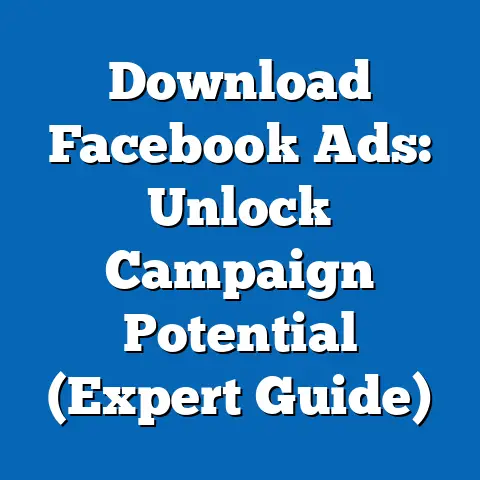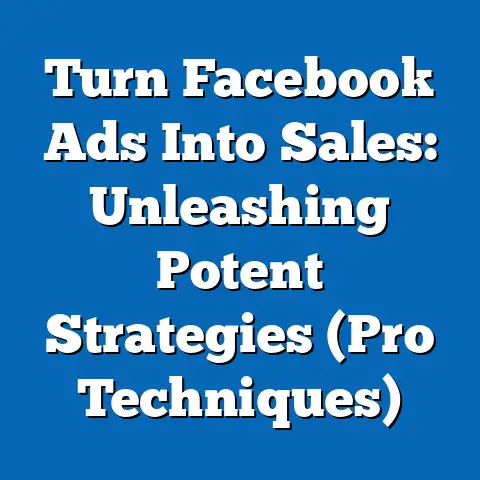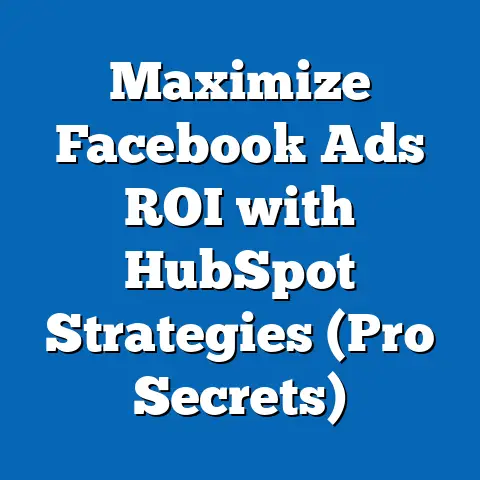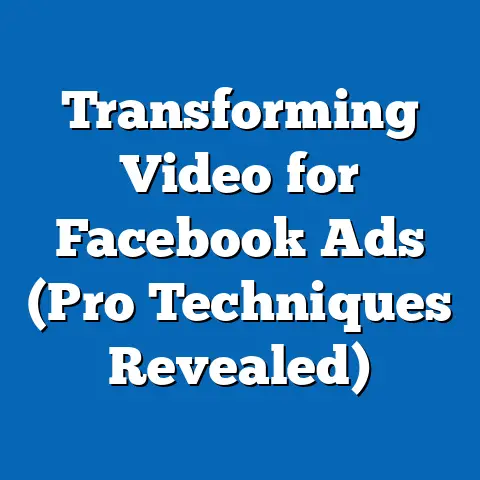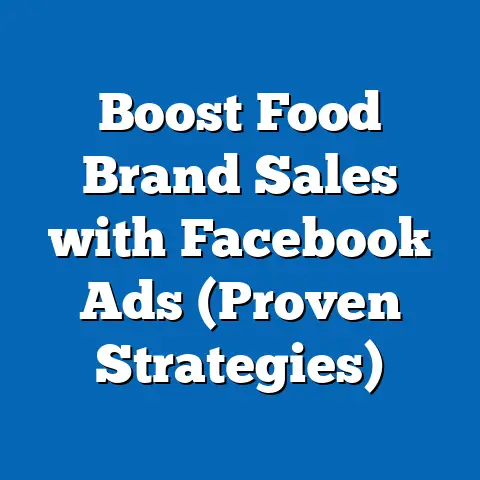Mastering fb ad Week Strategies (Expert Insights Revealed)
In today’s competitive digital landscape, every business is looking for the holy grail: value for money. We’re all striving to stretch our marketing budgets further, to squeeze every last drop of ROI from our advertising efforts. Facebook advertising, with its massive reach and sophisticated targeting capabilities, remains a powerful tool. But to truly harness its potential, we need to constantly refine our strategies, adapt to new trends, and learn from the best in the business. That’s where Facebook Ad Week comes in. It’s more than just a conference; it’s a concentrated dose of knowledge, innovation, and actionable insights that can transform your Facebook ad game. Let’s dive into how you can leverage the strategies revealed during Facebook Ad Week to boost your ROI and stay ahead of the curve.
Understanding Facebook Ad Week
Facebook Ad Week, now often integrated into broader Meta-centric events, serves as a crucial platform for advertisers of all levels. It’s essentially a concentrated learning experience, a deep dive into the ever-evolving world of Facebook advertising. Think of it as a summit where Meta, industry experts, and fellow marketers converge to share knowledge, unveil new features, and debate the future of the platform.
The significance of Ad Week lies in its ability to provide firsthand insights directly from Meta, along with perspectives from agencies and brands who are actively pushing the boundaries of what’s possible. These events typically feature a mix of sessions:
- Keynotes: These are usually delivered by Meta executives, outlining the company’s vision for the future of advertising and unveiling significant product updates.
- Workshops: Hands-on training sessions focused on specific aspects of Facebook advertising, such as advanced targeting techniques, creative best practices, or campaign optimization strategies.
- Panel Discussions: Industry experts discuss current trends, challenges, and opportunities in Facebook advertising, offering diverse perspectives and actionable advice.
- Case Studies: Real-world examples of successful Facebook campaigns, showcasing the strategies and tactics that drove results.
By attending (either virtually or in person) or actively following the key takeaways from these events, advertisers gain access to invaluable information that can directly impact their campaigns. I’ve personally found that attending these events helped me anticipate platform changes and adjust strategies proactively, giving me a significant edge.
Key Takeaway: Facebook Ad Week (and similar Meta-focused events) is a critical resource for staying informed about the latest trends, strategies, and best practices in Facebook advertising. Mark your calendar and make time to absorb the knowledge shared!
Key Strategies from Industry Experts
The real magic of Facebook Ad Week lies in the insights shared by industry experts. These are the people who are on the front lines, running campaigns, testing new strategies, and pushing the boundaries of what’s possible. Here are some key strategies I’ve picked up over the years, often reinforced and updated by the insights presented at Ad Week:
Data-Driven Targeting
In the age of information overload, generic advertising is a surefire way to waste your budget. Data-driven targeting is the cornerstone of effective Facebook advertising. It’s about using the wealth of data available to you – both within Facebook and from your own sources – to identify and reach the most relevant audiences.
- Leveraging Facebook’s Targeting Options: Facebook offers an incredibly granular level of targeting, allowing you to reach people based on demographics, interests, behaviors, and connections. Explore detailed targeting options to narrow your focus to the most likely customers.
- Custom Audiences: Upload your own customer data (email lists, phone numbers, website visitors) to create custom audiences. This allows you to target existing customers with specific offers or re-engage website visitors who haven’t yet converted.
- Lookalike Audiences: Expand your reach by creating lookalike audiences based on your existing customer data. Facebook will identify users who share similar characteristics and behaviors with your best customers, helping you find new prospects.
- Analyzing Customer Data: Don’t just blindly upload data; analyze it. Understand the demographics, interests, and behaviors of your best customers. Use this information to refine your targeting and create more personalized ad experiences.
I remember one campaign where we saw a 300% increase in conversion rates simply by refining our targeting based on a deep dive into our customer data. We discovered that a specific niche interest group within our broader target audience was significantly more responsive to our ads.
Key Takeaway: Data-driven targeting is not just a best practice; it’s a necessity. Leverage Facebook’s targeting options, custom audiences, and lookalike audiences, and always analyze your data to refine your approach.
Creative Content Development
Even the most precisely targeted ad will fall flat if the creative content doesn’t resonate with the audience. Compelling ad content is the key to capturing attention, driving engagement, and ultimately, converting prospects into customers.
- Storytelling: People connect with stories. Craft narratives that resonate with your target audience, highlighting the benefits of your product or service and showcasing how it solves their problems.
- Visuals: High-quality visuals are essential. Use eye-catching images and videos that grab attention and convey your message effectively. Consider using user-generated content or behind-the-scenes footage to build trust and authenticity.
- Video Content: Video is incredibly engaging and effective on Facebook. Experiment with different video formats, such as short-form videos, explainer videos, or customer testimonials.
- Relevance: Ensure your ad content is relevant to your target audience. Tailor your messaging and visuals to resonate with their specific interests and needs.
- Value Proposition: Clearly communicate the value proposition of your product or service. Why should people choose you over the competition? What problem do you solve?
I’ve learned that testing different ad creatives is crucial. What I think is brilliant might completely bomb, while a seemingly simple ad can take off. Never assume; always test.
Key Takeaway: Invest in creating compelling ad content that resonates with your target audience. Focus on storytelling, high-quality visuals, video content, relevance, and a clear value proposition.
A/B Testing Best Practices
A/B testing (also known as split testing) is the process of comparing two versions of an ad to see which one performs better. It’s a fundamental aspect of optimizing ad performance and maximizing ROI.
- Identify Variables to Test: Common variables to test include headlines, ad copy, images, videos, call-to-action buttons, and targeting options.
- Test One Variable at a Time: To accurately measure the impact of each variable, test only one at a time. Changing multiple variables simultaneously makes it difficult to determine which one is driving the results.
- Set Clear Goals: Before you start testing, define what you want to achieve. Are you trying to increase click-through rates, conversion rates, or engagement?
- Use Facebook’s A/B Testing Tool: Facebook offers a built-in A/B testing tool that makes it easy to create and run split tests.
- Analyze Results and Iterate: Once the test is complete, analyze the results and identify the winning variation. Then, use this information to refine your ad strategy and create new tests.
I’ve seen campaigns transformed through diligent A/B testing. Even small tweaks, like changing the color of a button or slightly altering the headline, can have a significant impact on performance.
Key Takeaway: A/B testing is essential for optimizing ad performance. Identify variables to test, test one at a time, set clear goals, use Facebook’s A/B testing tool, and analyze results to iterate and improve.
Leveraging Facebook’s Algorithm
Facebook’s ad algorithm is a complex system that determines which ads are shown to which users. Understanding how the algorithm works is crucial for maximizing campaign success.
- Quality Score: Facebook assigns a quality score to each ad based on its relevance, engagement, and overall user experience. Ads with higher quality scores are more likely to be shown to users and will often have lower costs.
- Bidding Strategies: Facebook offers various bidding strategies, such as automatic bidding, cost per click (CPC) bidding, and cost per impression (CPM) bidding. Choose the bidding strategy that aligns with your campaign goals and budget.
- Ad Placements: Facebook offers a variety of ad placements, including the Facebook News Feed, Instagram Feed, Audience Network, and Messenger. Test different placements to see which ones perform best for your target audience.
- Engagement: Facebook’s algorithm prioritizes ads that generate engagement, such as likes, comments, shares, and video views. Create content that encourages interaction and fosters a sense of community.
- Relevance: Ensure your ads are relevant to your target audience. The more relevant your ads are, the more likely they are to be shown to users and the higher your quality score will be.
One thing I’ve learned the hard way is that trying to “game” the algorithm is a losing strategy. Focus on creating high-quality, relevant ads that resonate with your audience, and the algorithm will reward you.
Key Takeaway: Understand how Facebook’s ad algorithm works and optimize your campaigns accordingly. Focus on quality score, bidding strategies, ad placements, engagement, and relevance.
Integrating Multi-Channel Marketing
Facebook advertising doesn’t exist in a vacuum. It’s most effective when integrated with other marketing channels, such as email marketing, content marketing, and search engine optimization (SEO).
- Consistent Branding: Maintain consistent branding across all your marketing channels. Use the same logo, colors, and messaging to create a cohesive brand identity.
- Cross-Promote Content: Promote your Facebook ads on other channels, such as your website, email newsletters, and social media profiles.
- Retargeting: Use retargeting to reach people who have interacted with your brand on other channels. For example, you can retarget website visitors who haven’t yet converted with Facebook ads.
- Data Integration: Integrate data from different marketing channels to gain a holistic view of your customer journey. This will help you understand how different channels contribute to your overall marketing goals.
I’ve found that a well-integrated multi-channel strategy not only boosts ROI but also strengthens brand awareness and customer loyalty.
Key Takeaway: Integrate Facebook advertising with other marketing channels to create a cohesive and effective marketing strategy. Focus on consistent branding, cross-promoting content, retargeting, and data integration.
Case Studies and Success Stories
The best way to understand the power of these strategies is to see them in action. Here are a few hypothetical case studies based on real-world scenarios and successes I’ve witnessed:
Case Study 1: E-commerce Brand Boosting Sales with Data-Driven Targeting
- Challenge: An e-commerce brand selling sustainable clothing struggled to reach new customers and increase sales.
- Strategy: They implemented data-driven targeting by analyzing their existing customer data to identify key demographics, interests, and behaviors. They then created lookalike audiences based on their best customers.
- Results: They saw a 150% increase in sales and a 50% reduction in cost per acquisition (CPA).
Case Study 2: Local Restaurant Driving Foot Traffic with Compelling Content
- Challenge: A local restaurant wanted to increase foot traffic and attract new customers.
- Strategy: They created compelling ad content featuring mouth-watering photos of their dishes, behind-the-scenes videos of their chefs, and customer testimonials. They targeted local residents within a specific radius of the restaurant.
- Results: They saw a 75% increase in foot traffic and a 40% increase in new customers.
Case Study 3: SaaS Company Generating Leads with A/B Testing
- Challenge: A SaaS company wanted to generate more leads and increase sign-ups for their free trial.
- Strategy: They implemented A/B testing to optimize their ad copy, headlines, and call-to-action buttons. They tested different variations to see which ones generated the most leads.
- Results: They saw a 100% increase in leads and a 60% reduction in cost per lead (CPL).
These case studies highlight the power of implementing the strategies discussed above. By focusing on data-driven targeting, compelling content, A/B testing, leveraging Facebook’s algorithm, and integrating multi-channel marketing, businesses can achieve significant results with their Facebook advertising campaigns.
Future Trends in Facebook Advertising
The world of Facebook advertising is constantly evolving. New features, algorithms, and best practices are emerging all the time. Staying ahead of the curve is crucial for maintaining a competitive edge. Here are some future trends I see shaping the landscape, often discussed and debated during events like Ad Week:
- The Rise of AI: Artificial intelligence (AI) is playing an increasingly important role in Facebook advertising. AI-powered tools are being used to automate tasks, optimize campaigns, and personalize ad experiences.
- Privacy Regulations: Privacy regulations, such as GDPR and CCPA, are impacting how businesses collect and use data for advertising. Advertisers need to be transparent about their data practices and obtain consent from users before collecting their information.
- Sustainability and Ethical Advertising: Consumers are increasingly concerned about sustainability and ethical issues. Businesses that demonstrate a commitment to these values are more likely to attract and retain customers.
- Augmented Reality (AR) and Virtual Reality (VR): AR and VR are emerging technologies that offer new opportunities for immersive advertising experiences. Businesses can use AR and VR to create interactive ads that allow users to try on products virtually or explore virtual environments.
By staying informed about these trends and adapting their strategies accordingly, businesses can continue to thrive in the ever-changing world of Facebook advertising.
Conclusion
Mastering Facebook ad strategies is essential for achieving value for money in your advertising campaigns. By understanding the key concepts, implementing best practices, and staying informed about future trends, you can maximize your ROI and achieve your business goals. Remember to constantly seek knowledge, adapt to new insights, and be proactive and innovative in your approach. Embrace the learning opportunities provided by events like Facebook Ad Week and never stop testing and optimizing your campaigns. The world of Facebook advertising is dynamic and exciting, and by embracing a growth mindset, you can unlock its full potential and achieve remarkable results.

